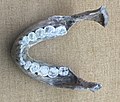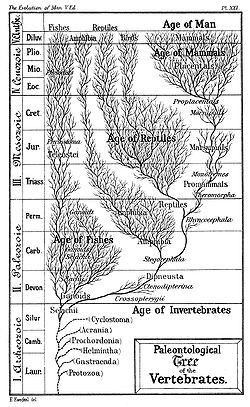"LB1". Homo floresiensis is thought to have arrived on Flores around 1.27–1 million years ago. There is debate as to whether H. floresiensis represents...
73 KB (7,636 words) - 21:49, 14 April 2025
size. Much like H. floresiensis, H. luzonensis presents a number of characteristics more similar to Australopithecus and early Homo than to modern humans...
15 KB (1,683 words) - 05:18, 5 March 2025
H. floresiensis was placed with Australopithecus sediba, H. habilis and Dmanisi Man, raising the possibility that the ancestors of H. floresiensis left...
95 KB (8,053 words) - 14:51, 12 April 2025
folklore is a product of ancient contact between modern humans and Homo floresiensis, a hominid species that inhabited Flores until c. 50,000 years ago...
7 KB (788 words) - 06:43, 14 April 2025
Homo floresiensis is currently thought to be Homo habilis, but this is subject to change with new information. Tooth wear from Homo floresiensis implies...
38 KB (5,040 words) - 11:31, 4 April 2025
region is of some importance in paleoanthropology, e.g. Homo erectus in Java, Homo floresiensis in Flores, and until the early anatomically modern human...
27 KB (3,531 words) - 08:48, 19 December 2024
Laron syndrome (section Homo floresiensis)
Arabia, Japan, and China. Recent publications have proposed that Homo floresiensis represented a population with widespread Laron syndrome, based upon...
28 KB (2,883 words) - 18:38, 17 November 2024
boisei Homo – immediate ancestors of modern humans Homo gautengensis† (probable H. habilis specimens) Homo rudolfensis† Homo habilis† Homo floresiensis† Homo...
30 KB (2,981 words) - 06:06, 26 February 2025
Human taxonomy (redirect from Homo sapiens sapiens)
descendant species such as Homo ergaster, Homo floresiensis, Homo antecessor, Homo heidelbergensis and indeed Homo sapiens is not entirely clear. The type fossil...
35 KB (5,139 words) - 01:00, 17 April 2025
Human evolution (redirect from Evolution of Homo sapiens)
an ongoing debate over whether H. floresiensis is indeed a separate species. Some scientists hold that H. floresiensis was a modern H. sapiens with pathological...
264 KB (26,349 words) - 07:16, 18 April 2025
Teuku Jacob (section Homo floresiensis)
remains discovered in Flores belonged to a new species in the genus Homo, Homo floresiensis. Jacob studied at Gadjah Mada University's School of Medicine from...
7 KB (590 words) - 14:36, 26 February 2025
shows that Homo floresiensis likely became extinct 50,000 years ago, around the time of modern human arrival to the archipelago. H. floresiensis skull, Cantonal...
63 KB (6,839 words) - 04:20, 15 April 2025
been known from such a recent date in Africa. The smaller-brained Homo floresiensis of Indonesia lived on an isolated island and, apparently, became extinct...
56 KB (6,299 words) - 15:48, 3 April 2025
Brain size (section H. floresiensis' small brain)
division of labor and sharing of information as possible causes. Homo floresiensis is a hominin from the island of Flores in Indonesia with fossils dating...
54 KB (6,276 words) - 14:31, 13 January 2025
holotype specimen of Homo floresiensis, also known as the "hobbit." Despite the small stature and brain size, Homo floresiensis was capable of using stone...
18 KB (2,069 words) - 10:00, 8 April 2025
discovery of Homo floresiensis in the nearby Liang Bua cave in 2003. The Rampasasa have since been reported as claiming Homo floresiensis as their ancestor...
3 KB (253 words) - 09:59, 7 August 2024
Denisovan (redirect from Homo Denisovan)
west), the second known human species to do so, along with earlier Homo floresiensis. By this logic, they may have also entered the Philippines, living...
75 KB (7,681 words) - 15:06, 12 April 2025
Neanderthal (redirect from Homo sapiens neanderthalensis)
humans in Europe Homo floresiensis – Extinct small human species found in Flores Homo luzonensis – Archaic human from Luzon, Philippines Homo naledi – South...
132 KB (13,350 words) - 00:58, 13 April 2025
with records of two other hominin populations, the Denisovans and Homo floresiensis. Japan was once linked to the Asian mainland by land bridges via Hokkaido...
38 KB (4,108 words) - 01:41, 14 April 2025
associated with stone tools produced by the dwarf archaic human species Homo floresiensis, with a small number of the bones bearing cut marks. The ambiguous...
38 KB (4,054 words) - 21:29, 4 March 2025
Dean Falk (section Homo floresiensis)
emergence of language. She and colleagues described the brain of Homo floresiensis ("Hobbit") in 2005. In 2013, Falk and colleagues described the cerebral...
13 KB (1,701 words) - 04:45, 14 December 2024
Mata Menge (section Comparison to H. floresiensis)
smaller than those of Homo floresiensis. The size and shape of the teeth of the Mata Menge fossils are similar to those of H. floresiensis, but the Mata Menge...
15 KB (1,436 words) - 07:34, 21 May 2024
within molar size up until Homo floresiensis, where smaller molars were beginning to be expressed. Species after H. floresiensis such as H. heidelbergensis...
26 KB (3,012 words) - 06:57, 28 July 2024
Prehistoric Indonesia (section Homo floresiensis)
descended from Homo Erectus and reduced in size over thousands of years by a well known process called island dwarfism. Homo floresiensis was first dated...
36 KB (4,133 words) - 09:53, 30 March 2025
Timeline of human evolution (section Homo)
Richard G. (30 March 2016). "Revised stratigraphy and chronology for Homo floresiensis at Liang Bua in Indonesia". Nature. 532 (7599): 366–69. Bibcode:2016Natur...
88 KB (3,504 words) - 00:31, 17 April 2025
an equally sized continental ancestor. Similarly, the early human, Homo floresiensis, had a brain of similar size to that of the significantly earlier...
30 KB (3,172 words) - 11:08, 14 February 2025
the Philippines, in 2007, and were designated as a species in 2019. Homo floresiensis, another archaic human from the island of Flores in Indonesia, stood...
57 KB (5,823 words) - 16:43, 20 March 2025
Homo sapiens had historically encroached upon the ecological and existential space of other species within the genus Homo, such as Homo floresiensis and...
17 KB (1,371 words) - 09:22, 17 April 2025
and had been involved in the discovery of fossilised remains of Homo floresiensis, which he nicknamed "The Hobbit" at a Queensland university. The Heelers...
24 KB (1,827 words) - 12:48, 9 April 2025
Human (redirect from HomoSapiens)
Humans (Homo sapiens) or modern humans are the most common and widespread species of primate, and the last surviving species of the genus Homo. They are...
268 KB (25,675 words) - 21:30, 12 April 2025























